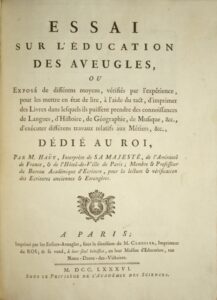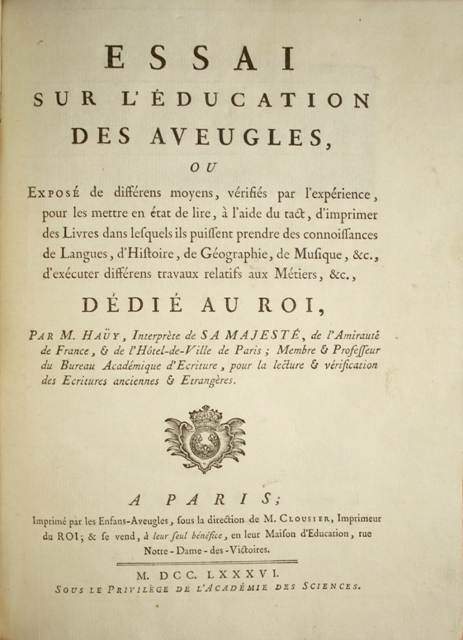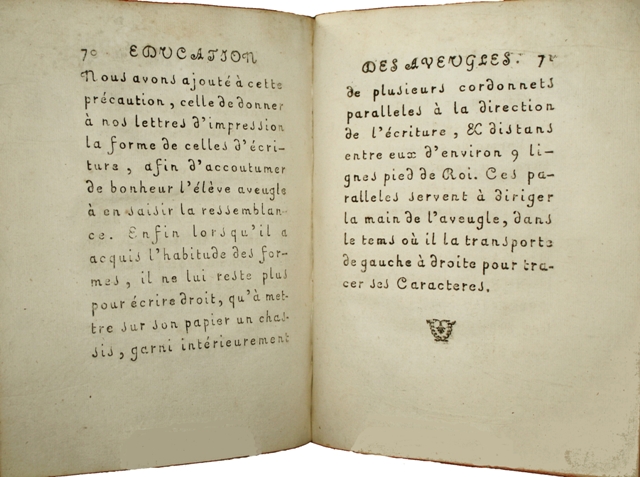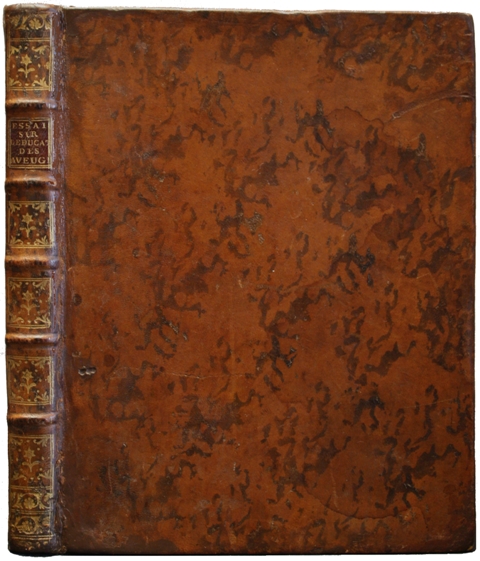Paris, Imprimé par les Enfans-Aveugles, sous la direction de M. Clousier, Imprimeur du Roi, 1786.
4to [246 x 190 mm] of (1) bl.l, vii pp. 1 to 111 printed with embossed characters, pp 113 to 126, 15 pp., (1) l., (11) ll. presenting various printed works that can easily be executed by blind children, (1) l. of observation, (3) ll. with the « Programme des exercices que les enfans-aveugles feront à Versailles » in front of the king, (3) ll., (1) bl. l.Bound in contemporary full marbled calf, spine ribbed, edges red. Binding skillfully restored. Contemporary binding.
Rare first edition of « the first printed book intended to be read by the blind ».
GM 5833; Lende p.15; PMM 292; En Français dans le texte 242; Norman 1023.
Valentin Haüy (1745-1822) wanted to make the blind read. In 1784 he created special characters that would produce an embossed typography. In 1786 he published the present work to expound his revolutionary method to educate the blind. The present book was printed by blind children with embossed letters.
In 1786 Haüy published the present work to expound his revolutionary method to educate the blind.
The present book was printed by blind children with embossed letters under the direction of the editor Clousier. The letteres are embossed, in order to be read by the blind who run through the lines from the tip of the fingers.
The work is dedicated to Louis XVI and is presented to him during a session organized on December 26th 1786 in Versailles by a dozen of Hauy’s pupils who indulge in convincing demonstrations. “The courtier’s admiration was not sterile: the king took the institution under his his wing, ordered to make the necessary funds for 120 pupils, granted to the professor the title of interpreter secretary of the king and admiralty of France for the English, German and Deutsch languages, and appointed him member of the Bureau académiques des écritures.”
In 1806, Haüy created the school for blind in Berlin, then the one of St-Petersburg in 1808, on the Emperor of Russia’s initiative.
“Valentine Haüy was the first to devise type that could be read by the blind. Characters slightly different in shape from ordinary italic were embossed on heavy paper to be read with the fingers. He founded the Institut Royale des Jeunes Aveugles in 1785 and seems actually to have succeeded in teaching some of his pupils not only to read by this method but to set and print the embossed type. His ‘Essai sur l’Education des Aveugles’, 1786, is an incunable of the method”. (PMM 292).
The copy is printed on thick paper and the first 111 pages present embossed characters permitting the blind to read.
A good copy of this important work for the history of science, a work that symbolizes the philanthropic outburst to the underprivileged classes in 18th century France.
See less information




